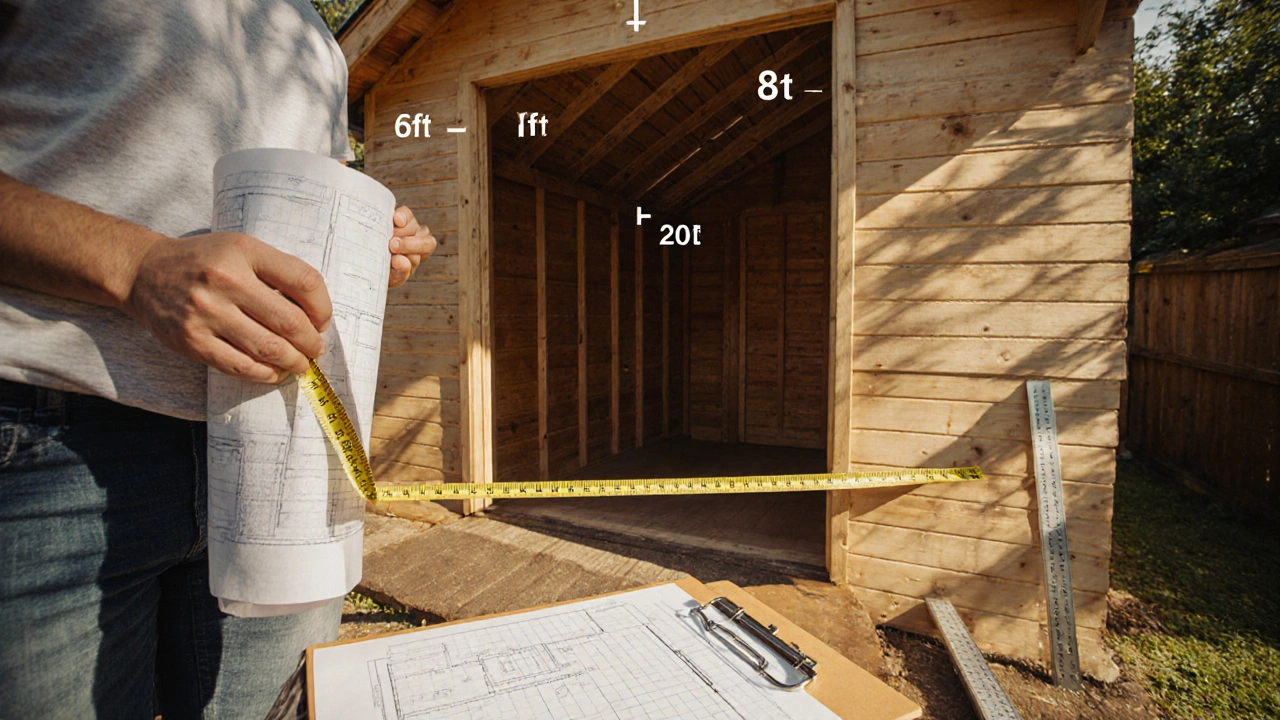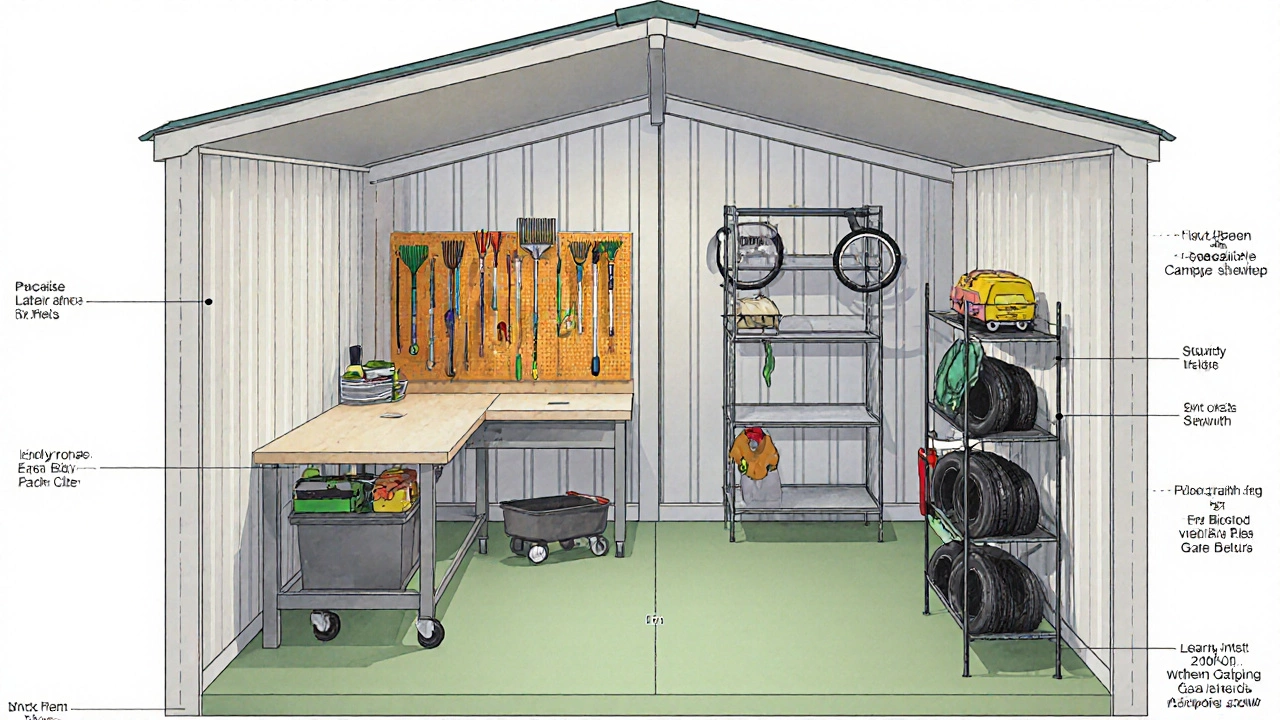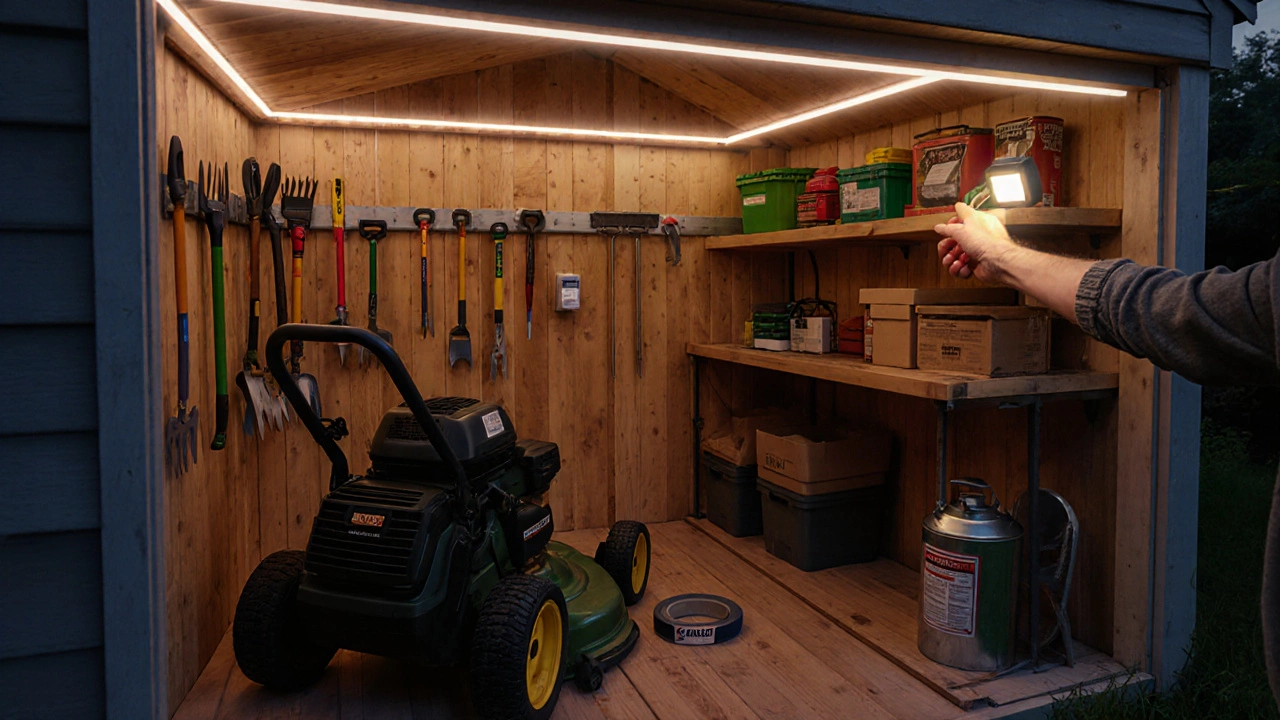What Fits in a 10x20 Shed? Space‑Saving Ideas & Layout Tips

10x20 Shed Storage Planner
Total Floor Area: 200 sq ft
Available Floor Space: 180 sq ft (after subtracting door swing)
Shed Dimensions: 10 ft × 20 ft
Maximum Ceiling Height: 8 ft
Recommended Aisle Clearance: 2 ft
No items added yet.
Key Takeaways
- Plan your floor plan first - know the exact dimensions of the shed, door opening, and ceiling height.
- Group items by use and size; keep heavy, infrequently‑used gear near the back.
- Vertical storage (shelves, racks, hooks) can add up to 70% more usable space.
- Measure each item before you bring it in - a typical lawn mower needs 4ft×2ft of floor space.
- Leave a 2‑ft aisle for safe access and quick retrieval.
Understanding the 10x20 Shed Footprint
10x20 shed is a compact structure most homeowners choose for a backyard workshop or extra storage. It offers roughly 200sqft of floor area (10ft×20ft) and a typical ceiling height of 8ft, giving you about 1,600cubicft of volume. The standard double‑door width is 6ft, but many models have a narrower 4‑ft door. Knowing the exact clearance around the door frame is crucial - you’ll need at least 6inches of wiggle room for larger items like a bike or a small mower.
In plain terms, the shed is about the size of a small one‑car garage. That’s enough room for a workbench, a few shelves, and a handful of garden tools, but you’ll have to be smart about layout if you want to avoid a cluttered mess.
Essential Measurements Before You Pack
10x20 shed can hold a lot, but only if you respect three key dimensions:
- Floor space: 200sqft. Subtract the door swing (usually 3ft×3ft) and any built‑in windows.
- Ceiling height: Most sheds have an 8‑ft ceiling, but some budget models drop to 7ft. Measure the height at the back wall and at the front wall because roofs can slope.
- Door opening: Record the clear width and height of the door when fully opened. This tells you the largest item you can drive or wheel in.
Take a piece of graph paper, sketch the floor plan to scale (1sqft = 1mm), and start blocking out zones.

Common Household Items and Their Space Requirements
Below is a quick reference for the most typical shed occupants. Dimensions are approximate; always measure your own equipment before committing.
| Item | Floor footprint (ft×ft) | Height (ft) | Typical weight (lb) |
|---|---|---|---|
| Garden tools | 2×3 | 3 | 30‑150 |
| Lawn mower | 4×2 | 3.5 | 150‑250 |
| Bicycle | 3×6 (standing) | 4 | 25‑35 |
| Workbench | 5×2 | 3 | 80‑120 |
| Shelving unit | 2×4 (per unit) | 6‑7 | 50‑100 |
| Winter tires | 2×5 (stacked) | 1.5 | 30‑45 each |
| Camping gear | 3×4 | 5 (tents stacked) | 80‑120 |
| Small car (e.g., Mini Cooper) | 12×6 (requires 8‑ft height) | 4.5 | 2,600‑2,800 |
| Utility trailer | 8×4 | 3 | 500‑900 |
Notice that the biggest single footprint belongs to a small car - it barely fits, and you’ll need to clear the interior of anything else. Most owners never store a vehicle inside a 10x20 shed; instead, they reserve the space for tools, seasonal gear, and a modest work area.
Smart Layout Strategies
Think of your shed as a miniature warehouse. The most efficient setups follow three rules:
- Zoning: Keep like‑items together. Create a “garden zone,” a “work zone,” and a “seasonal zone.”
- Vertical stacking: Use floor‑to‑ceiling shelves for boxes, cans, and lighter gear. A 6‑ft shelf system can store up to 1,200lb when properly anchored.
- Aisle clearance: A 2‑ft wide central aisle lets you move a wheelbarrow or a small cart without jolting other items.
A common layout starts with a workbench placed against the back wall, shelves on either side, and a garden‑tool rack near the front door for quick grab‑and‑go.
Examples of What You Can Store
Below are realistic groupings that fit comfortably when you follow the zoning principle.
Garden Zone (≈70sqft)
Garden tools - rakes, shovels, and pruners can hang on a pegboard mounted 4ft high. A pair of rolling garden carts tucked under a wall‑mounted shelf uses just 2×3ft.
Potting soil - stack four 5‑gal bags on a low shelf; each bag occupies about 1ft×1ft.
Lawn mower - place it perpendicular to the back wall, leaving a 3‑ft clearance for the handle.
Work Zone (≈40sqft)
A sturdy Workbench (5×2ft) with a built‑in pull‑out drawer occupies the rear‑center wall. Add a pegboard above for hand tools.
A rolling tool chest (3×1ft) slides under the workbench, making use of dead‑space.
Seasonal & Recreation Zone (≈60sqft)
Store Bicycles vertically using a wall‑mounted bike rack; each bike needs roughly 1ft×3ft of wall length.
Winter tires stack on a low shelf. Four tires take up about 2×5ft.
A compact Camping gear set (tent, sleeping bags) can sit on a collapsible shelf that folds when not in use.
If you need to store a Utility trailer, position it at the back with the door fully open, but you’ll have to give up most of the other zones.

Maximizing Every Inch: Shelving, Hooks, and Racks
Here are a few affordable tricks that add storage without expanding the footprint:
- Heavy‑duty metal shelves: Choose 3‑inch thick planked shelves that can bear 300lb per level. Three levels give you 9ft of horizontal storage in a 3‑ft wide slot.
- Ceiling‑mounted racks: Perfect for hanging ladders, hoses, or even a compact snowblower. Use swivel hooks to keep the rack reachable.
- Magnetic strip panels: Ideal for metal tools like screwdrivers, pliers, and small wrenches. A 4‑ft strip holds 30‑40 pieces.
- Fold‑down workbench: When not in use, lower the bench and lock it against the wall, freeing the floor for a bike or mower.
Every addition should be anchored to the shed’s studs or frame to prevent wobble, especially in windy climates.
Safety, Accessibility, and Weather Protection
Storing heavy gear off the ground protects it from moisture and pests. Install a simple vapor barrier under the floor if you live in a humid area. Good lighting (LED strips) makes it safer to retrieve items after sunset.
For fire safety, keep flammable liquids like gasoline in a metal safety can, stored on a separate shelf away from heat sources. If you store a small car or trailer, ensure the shed has adequate ventilation to avoid exhaust buildup.
Quick Checklist Before You Finish
- Measure door opening, ceiling height, and floor dimensions.
- Sketch a scaled floor plan and assign zones.
- Choose shelving and rack systems that reach the ceiling.
- Label boxes and bins for fast identification.
- Secure heavy items to the floor or walls.
- Install lighting and a moisture barrier if needed.
Frequently Asked Questions
Can I fit a small car inside a 10x20 shed?
A compact car like a Mini Cooper barely fits length‑wise (about 12ft) and requires the full 8‑ft ceiling height. You would have to forgo most other storage, so it’s technically possible but rarely practical.
What is the best way to store a lawn mower?
Place the mower perpendicular to a wall, leaving at least 3ft in front for the handle. If you have a roll‑up door, position the mower near the back so you can wheel it out without moving other items.
How high can my shelves be?
Aim for a top shelf no higher than 6‑ft so you can reach it safely with a step stool. In an 8‑ft shed you can add a second tier above the 6‑ft shelf, but only for light items.
Should I install a vapor barrier?
If you live in a region with high humidity or frequent rain, a 6‑mil polyethylene sheet under the floor slab can prevent moisture from seeping into stored boxes and tools.
What lighting works best in a shed?
LED strip lights attached to the ceiling provide even illumination and use very little power. Pair them with a motion‑sensor switch so the lights turn on only when you enter.